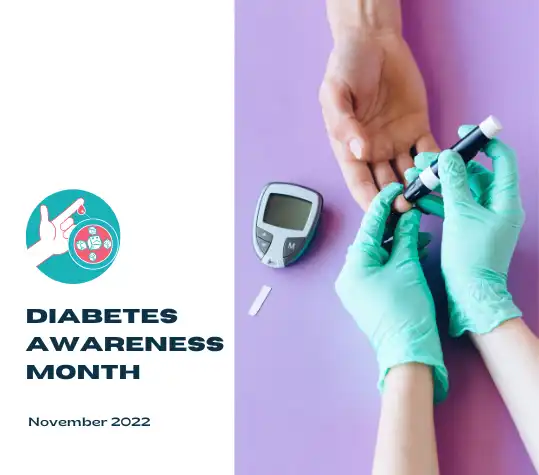Written and medically reviewed by Dorcas Morak, Pharm.D
November is another chance to show about 30 million Americans (1 person in every 10) what life with diabetes is really like. The high number of Americans with diabetes shows how relevant you are to raising awareness, as someone close to you most likely lives with diabetes. It is the year to come together and ring the alarm on the diabetes epidemic! Let’s educate those who are at risk and encourage those living with it to tell their stories
What is the Goal of Diabetes Awareness Month
The goal of celebrating Diabetes Awareness Month:
- Increasing collective understanding of diabetes.
- Learning to spot the warning signs of prediabetes.
- Knowing how to prevent or slow down the progress of prediabetes to diabetes.
- Prevent the complications of diabetes for people that live with it
What is Diabetes?
Diabetes is a metabolic disease where your body can't produce enough or is not sensitive to insulin. Insulin is a hormone produced in the pancreas that helps your body to store excess glucose for use in between meals when the level of glucose falls. Diabetes can be managed with insulin or other medications depending on the type you suffer.
Diabetes Facts
- Diabetes can affect both children and adults. 1 in 6 live births is affected by high blood sugar (glucose) in pregnancy (gestational diabetes).
- Diabetes constitutes a huge public health burden and was responsible for 10% ($760 billion) of the total health spending in 2019.
- About 30 million Americans (1 in every 10) suffer from diabetes.
- Diabetes is a risk factor for severe COVID-19.
- Type 2 diabetes remains undiagnosed in about 50% of people who may have it .
- Diabetes complications include nerve damage, kidney damage, eye damage, etc.
- Diabetes is a growing concern in children. Nearly 200,000 children under 20 years have been diagnosed.
What are the medications used to treat diabetes?
Treatment options for diabetes depend on the type and the severity. Your doctor may prescribe any of the following drugs individually or in combinations acarbose (Precose), Insulin, metformin (Glucophage), alogliptin (Nesina), linagliptin (Tradjenta), saxagliptin (Onglyza), sitagliptin (Januvia), semaglutide (Ozempic), dulaglutide (Trulicity), exenatide (Byetta), liraglutide (Victoza), canagliflozin (Invokana), dapagliflozin (Farxiga), empagliflozin (Jardiance), pioglitazone (Actos), glyburide (Glynase), glipizide (Glucotrol), and glimepiride (Amaryl)
How to Support American Diabetes Month
Learn the warning signs: 1 in 3 American has prediabetes and about 84% of them are aware. So, knowing the signs of prediabetes will help arrest or slow its progress to type 2 diabetes. Also, the signs include:
- Frequent urination
- Intense frequent hunger and thirst
- Weight loss and fatigue
- High rate of infection, especially skin infections or vaginal thrush
Take an online risk assessment: assess your risk to develop type 2 diabetes using the free resources offered by the American Diabetes Association or use the CDC online survey to know whether to get a test for prediabetes.
Show your support: show people with diabetes support and encourage them to seek help on time. Let them know diabetes is not curable but manageable. You may relieve the burden of medications cost in people with diabetes by showing them how to use a RxLess discount coupon to enjoy up to 88% savings on their medications.
Share resources: if you are a diabetes patient, write down your personal experience and share it on your social media handle. Tell people what it is like, the myth about it, the diagnosis, etc. You can also share a short informative video.
Other forms of support you can show people with diabetes are:
- Encouraging them to eat healthily.
- Support them to cease smoking and drinking alcohol.
- Motivate them to partake in regular physical exercise.
- Offer to accompany them to their appointment or fill their prescription.
- Suggest learning about diabetes together or joining local support groups.
Snap a blue circle picture: snap with a blue circle at the beginning of the month to create awareness that it is diabetes awareness month. You can create your blue circle selfie from the resources of the International Diabetes Federation (IDF).
Listen to ADA Ask the Expert event: listen to a series of events by the ADA and see the reason why everybody should have a diabetes care and education specialist (DCES).
















